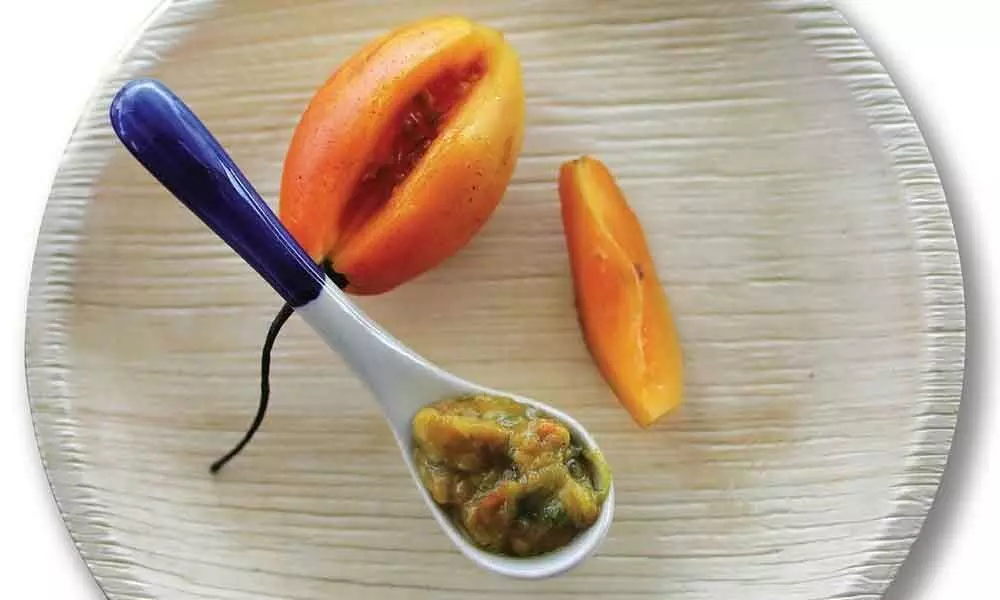Live
- All you need to know about PAN 2.0
- Akasa Air redefines travel experience with industry-first offerings
- MP: Residents stage protests against liquor shop in Indore
- Telugu Actor Shri Tej Booked for Alleged Cheating and False Promise of Marriage in Live-in Relationship
- Toyota Kirloskar Motor Celebrates 1 Lakh Urban Cruiser Hyryder on Indian Road
- MLS: New York City FC part ways with head coach Nick Cushing
- Delhi CM says Centre cutting AAP voters’ names from rolls, BJP hits back
- Hyderabad Metro Rail Phase-II Works to Begin in Old City in January 2025
- Odisha: 668 persons killed in human-elephant conflicts in last three years
- DEFENDER JOURNEYS: TO EMBARK ON ITS THIRD EDITION FROM NOVEMBER 2024
Just In
Nagaland tamarillos a worthy substitute for regular ones


Nagaland tamarillos a worthy substitute for regular ones
The tree tomato is so popular in Nagaland that the state government got a GI certificate
Many ingredients quintessential to Indian cuisines have come from the Americas or Europe. Some are well-known — potato, peanut, chickpea and chilli pepper — but there are some that remain relatively obscure. One such ingredient is the tree tomato (tamarillo) or Solanum betaceum, which has its origin in South America.
The tree tomato is so popular in Nagaland that the state government got a certificate for Geographical Indication (GI) for it in 2015. This certificate is provided to products that have a specific geographical origin and possess qualities innate to that origin.
The tree tomato in Nagaland meets these requirements because it has a long history of cultivation and several specific organoleptic characteristics related to taste and colour that evolved over time.
Since the Naga tree tomato is usually grown in kitchen gardens and farmers raise the seedlings from the mature old plants, the purity of the crop in the state has been maintained.
Red landscape
The tamarillo tree is found abundantly in kitchen gardens in all districts of the Naga hills, including Kohima, Wokha, Zunheboto, Kiphire, Tuensang, Mon and Phek. It is a small, evergreen tree with heart-shaped leaves and grows to about 3 metres. The fruits appear when the tree is around three years old and are distinctly egg-shaped.
They hang in clusters.
The skin of the fruit varies in colour — from yellow to purple — and is leathery and slightly bitter. The flesh of the fruit is more tart and tangy than the normal tomato. The seeds are flat, circular, larger and harder than those of the regular tomato. The pulp surrounding the seeds is soft, juicy and sweet. It has been observed that the yellow-skinned tomatoes are usually sweeter.
The tree tomato is locally known as sei bangenuo or khwüdi and the North Eastern Regional Agricultural Marketing Corp Ltd has been actively promoting the tree among farmers and ensuring traceability and quality. Other than the tree tomato, Nagaland also has the GI tag for Naga King Chilli (raja mircha) and both the tomato and the chilli are used to prepare a tangy chutney (see recipe).
The tree tomato has many advantages. It fruits through the year and the tomatoes can be stored for long even at room temperature. In times of scarcity of regular tomato, people easily shift to this perennial crop. This usually happens in winters when the common tomato becomes very expensive as it has to be imported from other states.
Juicy benefits
The tree tomato is high in pectin fibre, a natural preservative that can be used to make jellies, jams and chutney. The pectin level is as high as 5 per cent, which is higher than apples (1.0-1.5 per cent), apricots (1.0 per cent), cherries (0.4 per cent), oranges (0.5-3.5 per cent) and carrots (1.4 per cent). It is also rich in antioxidants, vitamins A and C, and is an excellent source of calcium, iron, potassium, phosphorus and magnesium.
In comparison to regular tomatoes, the tree tomato is richer in carbohydrates, protein, minerals and fibre but contains lesser fat. It is attributed with medicinal properties, too. It helps control high blood pressure and brings down cholesterol levels. Some people believe it helps lose weight and is often recommended for consumption after a workout.
Tomato is a staple in cuisines across India and having a no-fuss, cheap alternative is an attractive option. Researchers are already exploring this as a food option for a climate-risked world. It grows best in well-drained soil and cannot tolerate prolonged drought or waterlogged conditions.
For instance, researchers from Ecuador, Spain and India studied tree tomatoes grown under two different environmental conditions — traditional cultivation in the open field and under greenhouse conditions. They found that though traditional practices in the open field are less productive, treatment with organic fertilisers increases productivity. The team reported the findings in PLoS One in December 2017. This is good news for Nagaland where organic farming is widely prevalent.
As tamarillo is not found in its wild state, its centre of origin is not known. It is considered to be native to the Andes of Peru and Chile, Ecuador and Bolivia. Tamarillos are grown commercially in South and Central America, Australia, Africa and Asia.
In New Zealand, tamarillos were promoted during World War II when import of fruits such as bananas and oranges was not possible. This was to ensure that people got adequate vitamins. Before the kiwifruit boom of the 1960s, more hectarage was devoted to tamarillos than to the kiwifruit.
In the US, it is cultivated in California after US Department of Agriculture imported seeds from Argentina in 1913, but now it is grown mainly as an ornamental. .If demand for the tamarillo increases, it would be good news for Nagaland which already has a GI tag for the fruit and is promoting cultivation.

© 2024 Hyderabad Media House Limited/The Hans India. All rights reserved. Powered by hocalwire.com






